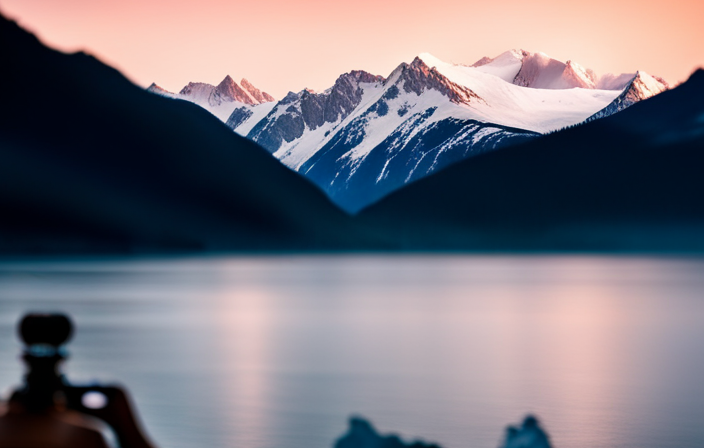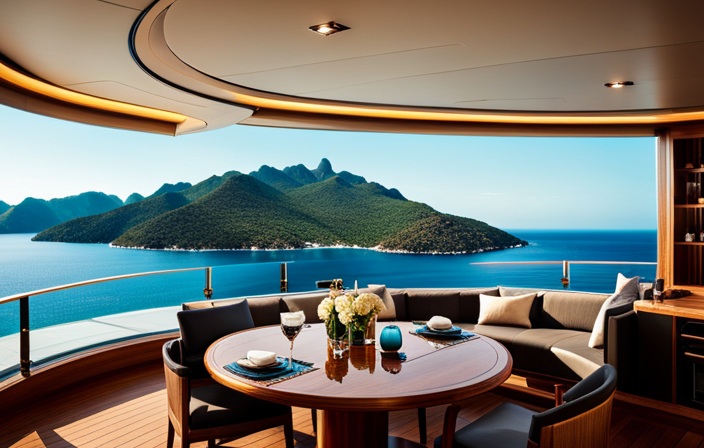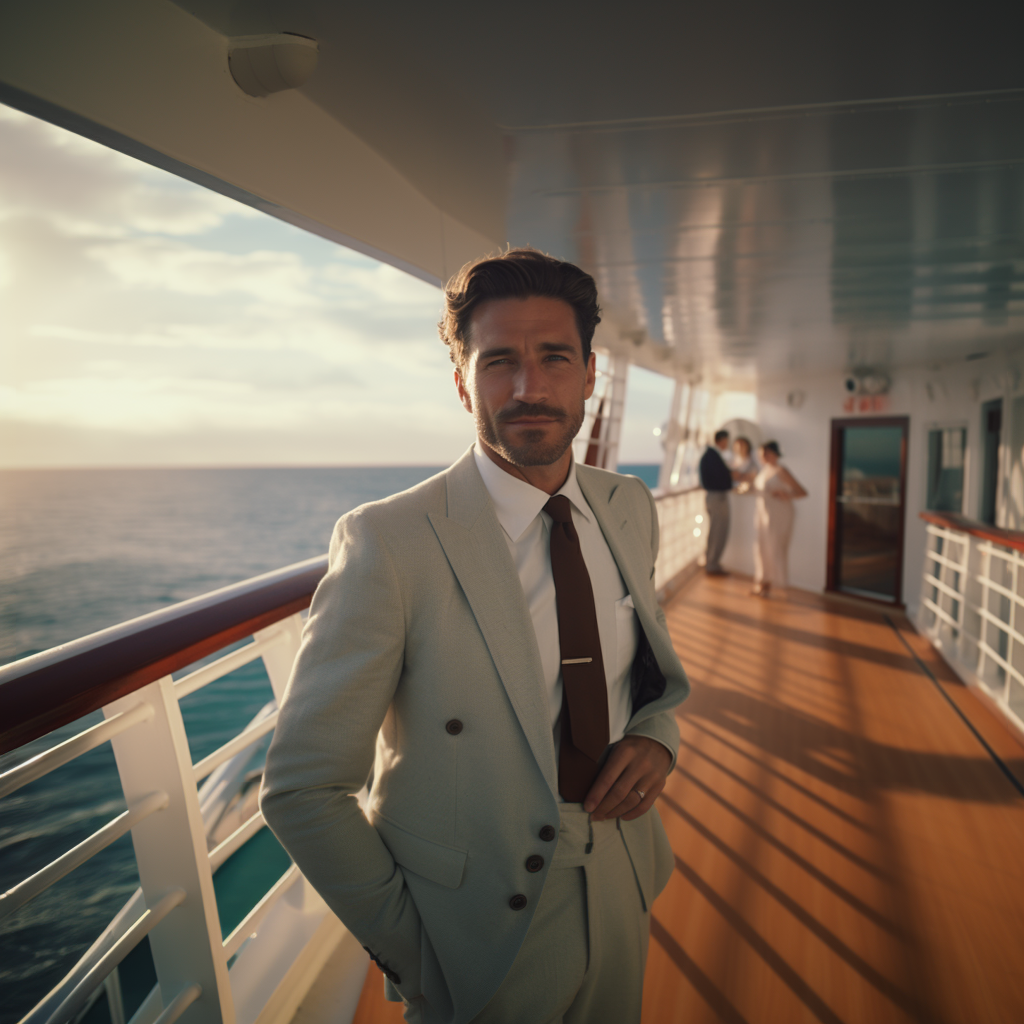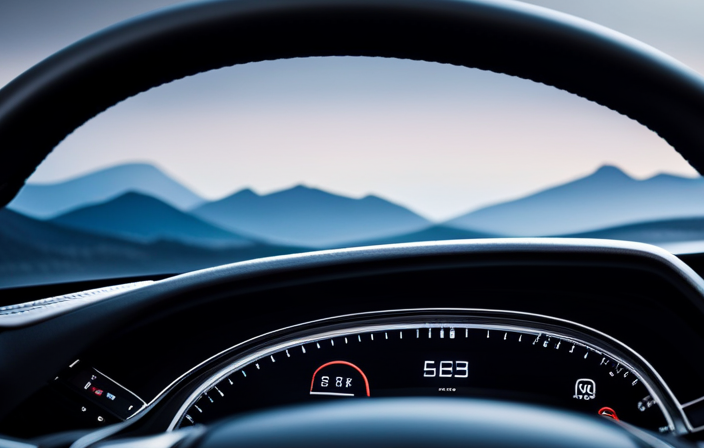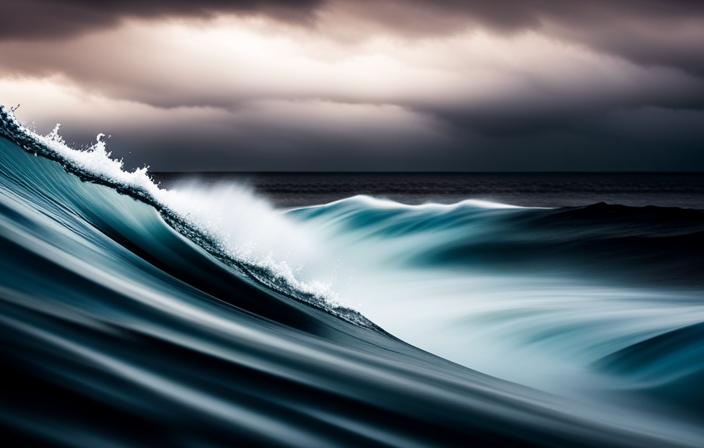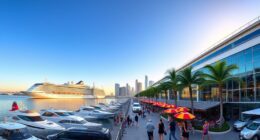Have you ever wondered what the perfect magnification for binoculars would be on an Alaska cruise? Look no further, as in this article, I will guide you through the essential factors to consider when choosing the ultimate binoculars for your wildlife viewing adventure.
Alaska is known for its stunning landscapes and diverse wildlife, and having the right binoculars can greatly enhance your experience. From the viewing distance and environment to the weight and portability, there are several aspects to take into account.
Additionally, understanding the basics of binocular magnification and opting for image stabilization technology can make a significant difference. Seeking recommendations, testing different models, and checking for additional features are also important steps in making an informed decision.
So, let’s dive in and discover the ideal binocular magnification for your Alaskan cruise!
Key Takeaways
- Finding a balance between cost and optical performance is important for budget and image quality.
- Seek recommendations and reviews from experienced cruisers to guide you towards the best binocular magnification.
- Lower magnification (8x) offers a wider field of view and is easier to stabilize, but sacrifices detail and may struggle with distant wildlife.
- Higher magnification (12x or above) provides greater detail and image clarity, ideal for close-up wildlife observation, but has a narrower field of view and may require a tripod for stability.
Consider the Viewing Distance and Environment
When choosing binoculars for your Alaska cruise, it’s important to consider the viewing distance and environment.
First, think about the viewing distance. Alaska is known for its vast landscapes and wildlife, so you’ll want binoculars that can bring those distant objects closer. A magnification of 8x or 10x would be ideal for most viewing distances on an Alaska cruise.
In addition to the viewing distance, you should also take into account the unpredictable weather conditions in Alaska. Rain, fog, and mist are common, so it’s crucial to choose binoculars that are waterproof and fog-proof. This will ensure clear and reliable viewing in any weather.
Understanding these factors will help you make an informed decision about the best binoculars for your Alaska cruise adventure.
Understand the Basics of Binocular Magnification
When it comes to binoculars, understanding magnification is key.
Magnification refers to how much closer an object appears through the binoculars compared to the naked eye.
To calculate magnification, divide the focal length of the binoculars by the focal length of the eyepiece.
It’s important to note that as magnification increases, the field of view decreases, meaning you see less of the surrounding area.
Learn how binocular magnification is calculated
To calculate binocular magnification, divide the focal length of the binoculars by the focal length of the eyepiece. This gives you the magnification range, such as 8x or 10x.
A higher magnification allows for more detailed viewing of objects, but it also narrows your field of view.
It’s crucial to strike a balance between magnification and field of view to fully appreciate the wider scenery.
Understand the relationship between magnification and field of view
Understanding the relationship between magnification and field of view is crucial when choosing binoculars for wildlife viewing. Higher magnification, such as 10x or 12x, allows for a closer look at animals in the distance. However, it also narrows the field of view, making it harder to track moving subjects. On the other hand, lower magnification, like 8x or 6x, provides a wider field of view, making it easier to locate and follow animals. This is especially useful when observing fast-moving creatures or scanning large areas. Ultimately, the choice of magnification depends on the specific wildlife viewing needs and preferences. It’s important to find a balance that allows me to observe animals up close while still being able to appreciate the overall environment. By considering both magnification and field of view, I can ensure a rewarding wildlife viewing experience.
Choose a Magnification Range Suitable for Wildlife Viewing
A suitable magnification range for wildlife viewing on an Alaska cruise is between 8x and 10x. With this range, you’ll have a good balance between magnification power and field of view. Here are three important factors to consider when choosing the right binoculars for wildlife viewing:
-
Viewing Distance Importance: In Alaska, you may encounter wildlife at varying distances. Binoculars with 8x to 10x magnification let you get a closer look without sacrificing too much field of view. This is crucial for observing animals in their natural habitat.
-
Environmental Factors: Alaska’s rugged terrain and unpredictable weather can make wildlife viewing challenging. Binoculars within this magnification range provide enough stability and clarity to compensate for shaky hands or unstable conditions.
-
Adaptability: Binoculars with 8x to 10x magnification are versatile enough to handle different situations. Whether you’re scanning the coastline for marine life or searching for birds in the treetops, these binoculars offer the flexibility needed for a diverse range of wildlife encounters.
Factor in the weight and portability of the binoculars when making your final decision, as these aspects will also play a significant role in your overall wildlife viewing experience.
Factor in the Weight and Portability
When choosing the right binoculars for your Alaska cruise, it is important to factor in the weight and portability. You want binoculars that are light enough to carry around all day without weighing you down, but also durable enough to withstand the rugged conditions of the outdoors.
Look for binoculars made from lightweight materials such as magnesium or polycarbonate, which offer a good balance between weight and durability. Additionally, consider the size and compactness of the binoculars, as you want them to be easily portable and fit into your daypack or backpack.
Opt for image stabilization technology to further enhance your viewing experience and eliminate any shakiness caused by hand movements.
Transitioning into the next section, image stabilization technology is an excellent feature to have when it comes to capturing clear and steady images of wildlife in motion.
Opt for Image Stabilization Technology
When it comes to choosing binoculars for my Alaska cruise, I’ve discovered the importance of opting for those with image stabilization technology.
Exploring binoculars with built-in image stabilization has been a game-changer for me, as it helps to counteract any shakiness in the environment.
The benefits of image stabilization are truly remarkable, as it allows for a much clearer and steadier view, ensuring that I don’t miss out on any breathtaking sights during my cruise.
Explore binoculars with built-in image stabilization
Explore binoculars with built-in image stabilization to truly enhance your experience on an Alaska cruise. These innovative binoculars offer a perfect solution for capturing steady and clear images, even in shaky environments. With binocular stability at its core, image stabilization technology significantly reduces the effects of hand tremors and vibrations. This ensures that you never miss a moment of the stunning landscapes and wildlife that Alaska has to offer. Whether you’re scanning the horizon for breaching whales or observing distant glaciers, the benefits of image stabilization cannot be overstated. Say goodbye to blurry images and frustratingly shaky views. With binoculars featuring built-in image stabilization, you’ll be able to immerse yourself fully in the awe-inspiring beauty of Alaska.
Now, let’s understand the benefits of image stabilization for shaky environments.
Understand the benefits of image stabilization for shaky environments
Imagine how much more enjoyable your experience would be if you could capture steady and clear images, even in shaky environments. Thanks to image stabilization technology, this is now possible with binoculars.
The benefits of image stabilization go beyond just reducing blur caused by shaky hands. With this technology, you can fully immerse yourself in the breathtaking landscapes of an Alaska cruise without worrying about your hands trembling.
Here are three reasons why image stabilization is a game-changer:
-
Enhanced clarity: Image stabilization minimizes vibrations, resulting in sharper and more detailed images.
-
Longer observation: The stabilization feature allows you to focus on a subject for a longer period, without straining your eyes or losing track.
-
Improved comfort: The stability provided by image stabilization reduces eye fatigue, making your viewing experience more comfortable.
Consider the budget and optics quality as you explore binoculars for your Alaska cruise, but don’t overlook the incredible benefits of image stabilization.
Consider the Budget and Optics Quality
Considering the budget and optics quality, finding a binocular magnification that strikes the perfect balance is crucial for getting the most out of your Alaska cruise experience.
For instance, imagine being able to spot a majestic humpback whale breaching the water’s surface with crystal-clear clarity, all without breaking the bank.
When it comes to budget considerations, it’s important to weigh the cost of the binoculars against their optical performance. While higher magnifications may offer a closer view, they can also be more expensive and result in a narrower field of view.
On the other hand, lower magnifications may be more affordable but sacrifice some detail. It’s important to find a balance that suits your budget while still providing good image quality.
Seeking recommendations and reading reviews from experienced cruisers can help guide you towards the best binocular magnification for your Alaska adventure.
Seek Recommendations and Reviews
Prepare to be amazed by the recommendations and reviews from experienced cruisers that will help you find the perfect pair of binoculars for an unforgettable Alaska adventure.
When it comes to selecting the right binocular magnification for your Alaska cruise, it’s crucial to weigh the pros and cons of various options. Here are three key factors to keep in mind:
-
Lower magnification (8x): Pros – wider field of view, easier to stabilize, better for scanning large areas. Cons – less detail and image clarity, may struggle to see distant wildlife.
-
Medium magnification (10x): Pros – good balance between field of view and detail, suitable for most situations. Cons – can be harder to stabilize, may cause image shake.
-
Higher magnification (12x or above): Pros – greater detail and image clarity, ideal for close-up wildlife observation. Cons – narrower field of view, harder to stabilize, may require a tripod for steady viewing.
To determine the right magnification, consider your specific needs and preferences. In the following section, we’ll explore how to test and compare different models.
Test and Compare Different Models
When it’s time to make a decision, nothing beats the hands-on experience of testing and comparing different binocular models. I found this to be especially true when searching for the best binocular magnification for an Alaska cruise.
During my research, I discovered that durability and low light performance were two crucial factors to consider. By testing various binoculars, I could assess their build quality and determine if they could withstand the rugged conditions of an Alaskan adventure. Additionally, I could evaluate their low light performance to ensure clear and detailed views even in dim lighting conditions.
After comparing different models, I gained a better understanding of which binoculars would be ideal for my cruise.
Now, let’s explore the next step: checking for additional features and accessories.
Check for Additional Features and Accessories
Once you’ve tested and compared different models, it’s time to check for any additional features and accessories that can enhance your binocular experience. Here are three essential items to consider:
-
Lens coatings: Look for binoculars with multiple layers of anti-reflective coatings on the lenses. These coatings reduce glare and improve light transmission, resulting in brighter and clearer images.
-
Waterproof and fogproof: Since you’ll be on an Alaska cruise, it’s crucial to have binoculars that can withstand the unpredictable weather conditions. Opt for models that are waterproof and fogproof, ensuring optimal performance even in wet and humid environments.
-
Tripod compatibility: If you plan on using your binoculars for extended periods or want to stabilize your view, consider models that are tripod compatible. This feature allows you to mount your binoculars on a tripod, reducing hand fatigue and providing a steady image.
By considering these additional features and accessories, you can make the final decision based on personal preference and ensure an enjoyable binocular experience throughout your Alaska cruise.
Make the Final Decision Based on Personal Preference
To make the final decision based on personal preference, it’s important to consider other factors as well. For example, the size and weight of the binoculars can play a role in your decision. If you plan on carrying the binoculars for long periods of time or on strenuous hikes, you may want to opt for a more compact and lightweight option. Additionally, the ergonomics of the binoculars should be taken into account. Make sure they feel comfortable in your hands and are easy to adjust and focus. Lastly, don’t forget about the accessories that come with the binoculars. Some models may include features like image stabilization, lens coatings, or a built-in compass. These additional features can enhance your viewing experience and may be worth considering. Ultimately, the final decision should be based on what feels right for you and what will enhance your enjoyment of the Alaskan outdoors.
Frequently Asked Questions
How do I factor in the weight and portability of binoculars when choosing the best magnification for an Alaska cruise?
When considering the weight and portability of binoculars, it’s important to find a balance. While higher magnification may provide a closer view, it often comes with added weight. Opting for a lightweight and compact option ensures ease of use during your Alaska cruise.
Are there any additional features or accessories that I should consider when selecting binoculars for wildlife viewing on an Alaska cruise?
When selecting binoculars for wildlife viewing on an Alaska cruise, it’s important to consider additional features and accessories. Look for waterproofing, image stabilization, and a tripod mount for steady viewing in any weather conditions.
Can you provide any recommendations or reviews for specific binocular models that are suitable for an Alaska cruise?
I highly recommend the Nikon Monarch 7 binoculars for an Alaska cruise. They have exceptional clarity and durability, making them perfect for wildlife viewing. Numerous positive reviews confirm their outstanding performance in various conditions.
Is image stabilization technology important for binoculars used on an Alaska cruise?
Yes, image stabilization technology is important for binoculars used on an Alaska cruise. It helps to reduce hand shake and provides a clear, steady view. Without it, you may experience difficulty in focusing on distant objects.
How can I test and compare different binocular models to find the best one for an Alaska cruise?
To find the best binocular for an Alaska cruise, I recommend testing and comparing different models. One interesting statistic is that the average price of binoculars with image stabilization technology is around $300.
Can I Use Binoculars on an Alaska Cruise to See Wildlife?
Yes, many cruise lines for Alaska offer wildlife viewing opportunities, and using binoculars on an Alaska cruise can enhance your experience. From bears to whales, binoculars can help you spot the diverse wildlife that calls Alaska home. Don’t forget to bring a pair on your next adventure.
Conclusion
After considering the viewing distance, environment, and understanding the basics of binocular magnification, it is important to choose a magnification range suitable for wildlife viewing.
Additionally, weight and portability should be factored in, along with the option of image stabilization technology.
Seeking recommendations and reviews, as well as testing and comparing different models, will help in making the final decision.
Checking for additional features and accessories can enhance the overall experience.
Ultimately, finding the best binocular magnification for an Alaska cruise is a matter of personal preference, ensuring a closer look at the breathtaking wildlife and scenery that awaits.
So, don’t miss out on the chance to ‘see the world through a different lens’ and make your Alaska cruise an unforgettable adventure.
Alfons is the visionary leader and driving force behind Voyager Info’s success. As the Editor in Chief, he brings a wealth of experience and an unwavering passion for travel to the helm of our cruise-centric platform.
With a lifelong fascination for exploring new horizons, Alfons discovered his love for the ocean and cruising at a young age. From sailing across pristine Caribbean waters to embarking on daring expeditions to far-flung destinations, he has amassed a treasure trove of first-hand experiences in the world of cruising.

